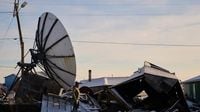When the remnants of Typhoon Halong slammed into western Alaska in October 2025, few could have imagined the scale of the devastation that would follow. Entire villages—remote, roadless, and deeply rooted in tradition—were inundated by floodwaters, their homes and food stores swept away in a matter of hours. The aftermath has left more than 1,600 people displaced, scattered across the state and grappling with an uncertain future, while the resilience of these communities is being tested like never before.
According to the Associated Press, the storm surge on October 11 brought a night of terror to places like Kwigillingok and Kipnuk. In Kwigillingok, longtime resident Harry Friend recounted how, as water rushed in, his house began to float and shake. "When the water started coming in, my house was floating, shaking, floating, shaking," Friend said. By morning, his siblings' homes—once just next door—were gone, carried off by the flood. The Coast Guard rescued dozens from rooftops, but the destruction was everywhere: homes lay scattered across the tundra, coffins were washed from above-ground cemeteries, and essential infrastructure was badly damaged.
For many, the choice to leave was wrenching. Darrel John, one of only seven residents who stayed behind in Kwigillingok, watched the last evacuees depart by helicopter and small plane. "I just couldn’t leave my community," he told AP, speaking from the town’s school, now serving as both shelter and command post. But with winter closing in and basic necessities in short supply, even the most steadfast are questioning how long they can hold out.
The scale of the disaster is staggering. As reported by weather.com, more than 1,500 people lost their homes in some of the harshest conditions on the continent. The floods didn't just destroy houses—they wiped out the food caches that local residents, many of whom rely on subsistence hunting and fishing, had painstakingly gathered to last through the brutal winter. As Scott Lingle, CEO of Bean’s Cafe in Anchorage, explained, "You're dealing with a population that goes out and hunts their own food. And we're talking about whale and we're talking about walrus and we're talking about seal oil and moose and caribou, things that 100% of the stores don't carry."
Feeding the evacuees and survivors became a monumental challenge. World Central Kitchen (WCK), known for its work in war zones and disaster areas, partnered with Bean’s Cafe and local chefs to provide nourishment and comfort. Carrie Hayes, WCK’s Director of Communications and Media Strategy, remarked on the unique logistical hurdles: "It was a little interesting to learn that here in the U.S., there are communities that are not connected to others by roads. That was unusual and fascinating."
To reach the scattered villages and evacuee hubs in Anchorage and Bethel, WCK and its partners relied on small planes, ATVs, and even dog sleds to deliver thousands of pounds of vegetables, fish, meat, and shelf-stable foods. The aim was not just to fill bellies, but to offer a taste of home and a measure of healing. "When you're experiencing something that for many people is the worst tragedy, hopefully you're ever gonna have to face, you want something that tastes like home. You want something that tastes familiar," Hayes said.
Traditional foods featured prominently on the menu. Salmon was prepared in myriad ways, including roasted salmon heads simmered for 24 hours to make rich chowder. Fry bread—Alaska’s answer to comfort food—was served alongside, offering a small but meaningful sense of normalcy. "It's just a little bit of comfort in a time when comfort is hard to come by," Lingle told weather.com. Since the disaster, WCK, Bean’s Cafe, and local partners have served more than 36,000 meals and distributed over 8,700 pounds of food.
But food is just one part of the recovery. The state, led by Governor Mike Dunleavy’s office, has focused on repairing damaged villages and supporting the displaced. The process is expected to take up to 18 months, and hundreds remain in temporary housing, many in Anchorage, far removed from their subsistence way of life. For families like the Johns, this abrupt transition brings daily challenges—from learning to navigate city life to grappling with unfamiliar rules about hunting and fishing. "Flushing toilets; we don’t have them back home," said Darrell John of Kipnuk, now living in a motel in Anchorage. But the changes go deeper. "I have no idea," he admitted when asked what he would do for work. "This was not a plan to be here."
The trauma of displacement is compounded by the uncertainty about whether these villages can survive in their current locations. Louise Paul, a longtime resident of Kipnuk, voiced the fears of many: "A lot of people have claimed they’re not returning. They don’t want to do this again. Every fall, we have a flood. It might not be as extreme as this one was, but as the years have set in, we’re seeing it. The climate warming is increasing the storms and they’re just getting worse and worse."
This region, where the Yukon and Kuskokwim rivers meet the Bering Sea, is one of the largest river deltas in the world. For thousands of years, Athabascan and Yup’ik people have lived off the land, fishing for salmon and hunting moose, walrus, seals, ducks, and geese. But now, as AP reports, rising seas, erosion, melting permafrost, and increasingly violent storms—fueled by climate change—pose existential threats to these villages. The Alaska Native Tribal Health Consortium’s 2024 report estimates that 144 Alaska Native communities face similar dangers, with $4.3 billion needed over the next 50 years to mitigate damage.
Relocating entire villages is a herculean task. The village of Newtok began planning its move in the 1990s, finally completing the relocation to Mertarvik last year at a cost of over $160 million. For Kwigillingok and Kipnuk, the path forward is unclear. Some, like Harry Friend, cling to hope: "This is our land. You’ve got to come back to your home." Others see no choice but to adapt to new lives elsewhere, their centuries-old traditions upended by forces beyond their control.
As work crews labor to repair boardwalks and restore essential services before winter’s grip tightens, the people of western Alaska are left to weigh their options. For now, the healing power of food, the solidarity of community, and the determination to endure provide some solace. But the question of whether these villages can withstand the next storm—or whether the next generation will return at all—remains heartbreakingly unresolved.




